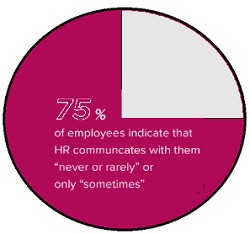It’s time to stop focusing on employee engagement.
With employee engagement rates remaining stagnant, you likely want to do anything but. Especially when you consider the fact that only 33% of employees are engaged at work, according to Gallup’s most recent State of the American Manager report.
But it’s because HR pros are so laser-focused on employee engagement that we’ve been missing the root of the problem: ineffective employee communication.
A 2017 survey of 1,200 U.S. workers by my team at EmployeeChannel, Inc. found non-desktop, remote, and corporate office employees all desire the same thing: More frequent and effective communication from their employer and, specifically, from their HR teams.
In fact, all three employee segments ranked “communicates frequently and effectively with employees” as one of the top two behaviors that create a positive experience at work. And all segments ranked “open communication to all employees” as one of the top two initiatives they wished their employer would focus on more.
To truly make communication a high priority within your organization, you and your HR team must first understand where employees feel you’re missing the mark.
The gap between perception and reality
In customer relationship management, analytics enable marketers to develop knowledge about customer needs, concerns, and preferences. This customer intelligence is used to deliver a better customer experience to increase brand loyalty.
In employee relationship management, communication analytics can enable HR and internal communication teams to develop knowledge abo ut employee needs, concerns, and preferences. This employee intelligence can be used to deliver a better employee experience to increase employee engagement and internal brand loyalty.
ut employee needs, concerns, and preferences. This employee intelligence can be used to deliver a better employee experience to increase employee engagement and internal brand loyalty.
Nearly half of employees from all three segments reported they were “neutral, disagreed, or strongly disagreed” that the HR team’s communication efforts made them feel more informed or engaged at work, according to our survey. And in a bruising indictment, 75% of survey respondents indicated that HR communicates with them “never or rarely” or only “sometimes.”
Now, before aiming that next palm slap at the author, a colleague, or an unsuspecting employee — stop! HR teams and their organizations are firmly committed to open communication, and HR teams invest a tremendous amount of time and effort in communicating with employees. The big question is why is there such a big gap between perception and reality? The likely problem is that communications too often fail to reach employees.
Poor employee communication may be the result of a vertical communication strategy where messages are cascaded down the management hierarchy like the children’s game telephone, in which the first person in a queue whispers a message in the ear of the next person down a line of people until the last person hears the message (or doesn’t). This form of top-down communication is growing increasingly obsolete.
Outdated technology
Poor communications may also be the result of the inherent weaknesses of older technologies or low-tech approaches. Bloated email boxes, stale intranets, and generic group messaging contribute to poor employee communication. And for some employees, limited-to-no digital access, different locations/time zones, and lack of face-time can contribute to poor communication.
However, before rushing to send more email, update the intranet, or schedule one-on-one meetings with employees, survey respondents also revealed more about their communication preferences: fewer than 12% of employees across all three segments wanted in-person meetings. Only 5% wanted the HR team to communicate with them via phone; 16% preferred email.
These responses are likely to make HR leaders feel like their hands are tied. Employees want to hear more from HR, but they prefer not to use the traditional channels available.
Some alternatives
There is hope. To communicate more frequently and effectively with employees, organizations will need to adopt a new communication model similar to the communication strategies, tools, and technologies used by their own customer relationship management teams.
- Develop a multi-channel strategy, recognizing that no single channel will meet all of the needs for employee communication.
- Adopt a “fit-to-purpose” model, where the communicator selects the channel that best matches the outcome they want to achieve. For example, focus social collaboration tools (e.g., Slack) on team, project, or task-based communications; focus email communications on private, one-to-one conversations with employees; and use intranets for data that changes infrequently.
- Deploy a dedicated, mobile channel for employer-to-employee messaging to mitigate the challenges of employees with limited-to-no digital access, different locations/time zones, lack of face-time, and the noise of shared channels that have numerous publishers who compete for employee mindshare.
- Measure the success of employee communication with the same discipline and rigor used to measure the impact and effectiveness of marketing messages.
You share a common goal with employees — improve internal communications. So, it’s time to develop an employee communication model supported by the right tools and behaviors to make it happen.
